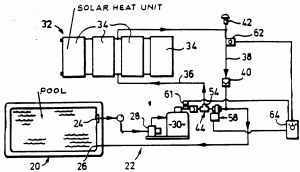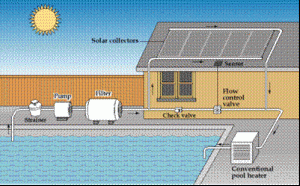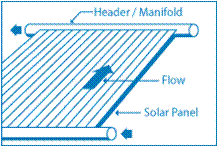
Typical Schematic of a Solar Pool Heating System. Solar systems are longer lasting and more reliable than gas and heat pump pool heaters.
The cost of a solar pool heating system ranges from $3,000 to $4,000 to purchase and install. The return on investment (ROI) is realized in 2 to 7 years depending on local cost of fuel. Solar systems are longer lasting and more reliable than gas and heat pump pool heaters. The return depends on many factors which one should investigate before selecting a solar pool heating system.
- Evaluate your site’s solar resource
- Determine the correct system size
- Determine the correct orientation and tilt for the collector
- Determine the system’s efficiency
- Compare system costs
- Investigate local codes, covenants, and regulations.
DIY Solar Pool Heater with Topsflow pump
The Department of Energy provides guidance and information on selection, design, and installation of solar pool heating systems.
EVALUATING YOUR SITE’S SOLAR RESOURCE
The site’s solar resource plays a very big role in design of a solar heating system. How much of the sun’s energy reaches the site at which your pool rests will determine the design and the efficiency of the solar pool heater.
Solar pool heating systems use both direct and diffuse solar radiation. Even if you do not live in a climate that is warm and sunny all the time the radiated energy is adequate to provide the heating needs of a small pool. A building site facing south with unshaded areas is a good candidate for a solar pool heating system. Consider asking your local supplier for a solar site analysis.
SIZING A SOLAR POOL HEATER
Several factors contribute to the sizing of a solar pool heating system. The size of the pool, the duration of use in a year, the average temperature of the duration, the desired pool temperature, the solar resource available determined from site analysis, the design characteristics of the system such as orientation and tilt of the collector, the efficiency of the collector and heat loss prevention. A knowledgeable contractor with the right tools should be able to demonstrate the basis for his design.
As a thumb rule the surface area of your solar collector should equal 50%–100% of the surface area of your pool. Areas with cloudier and cooler weathers may demand a higher ration between the area of the collector and the pool. A larger collector extends the duration of the pool’s usage.
In example, year-round use of a 15-by-30-foot outdoor swimming pool in Florida would typically require a collector with 100% of the pool’s square footage. This computes to 450 square feet of collector area. In northern California, where the swimming season is six to eight months the collector sizes are about 70% of the pool area. Pool covers play an important part in decreasing the area of the collector required.
The size of the pool pump for a solar system will depend largely on the collector’s ability to provide the heat required. In comparison to a conventional pool heating system a solar system demands a larger pump to move the pool’s water to and through the collectors.

